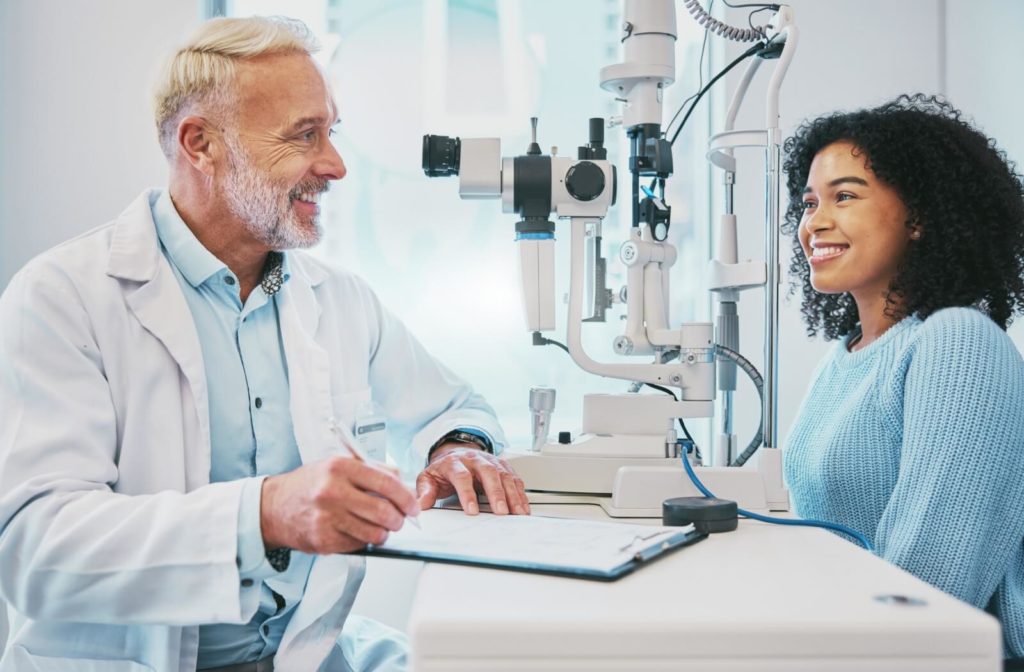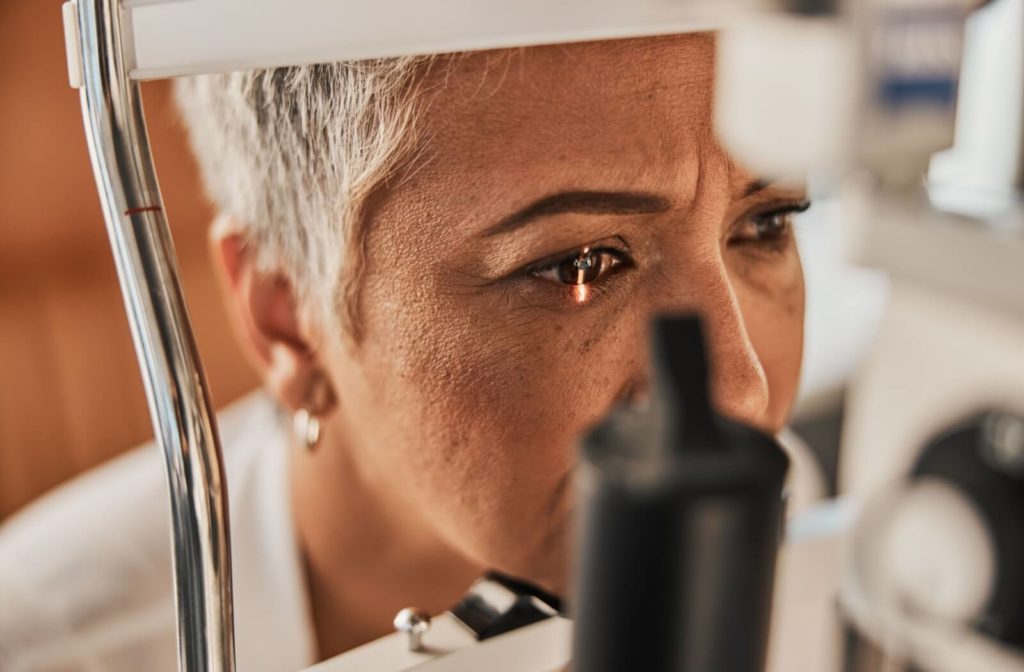Regular comprehensive eye exams are a lot more important than you might think. They aren’t just about checking your vision and getting you a new prescription; they’re about looking for the signs that something may be wrong. Plenty of different eye conditions can subtly develop without showing any obvious symptoms, and your optometrist is looking for them all.
Diseases that can be detected during an eye exam include:
- Refractive errors
- Dry eye syndrome
- Diabetes
- Cataracts
- Age-related macular degeneration
- Glaucoma
1. Refractive Errors
Your eye naturally refracts light to reach the retina—it’s the foundation of your visual system. However, sometimes the shape of the eye leads to light refracting incorrectly inside the eye. Conditions like myopia (nearsightedness) and hyperopia (farsightedness) are extremely common.
These usually develop in early childhood and often cause:
- Blurry vision
- Squinting
- Eye strain
- Headaches
- Difficulty seeing at night
If you or your child are experiencing these symptoms, it might be a sign of a refractive error. Fortunately, your optometrist can check your vision during your next eye exam and help to manage these symptoms effectively.
2. Dry Eye Syndrome
Your tear film is responsible for protecting and hydrating the eye. It requires a careful balance of components—water, oil, and mucus—to do this job. However, some factors can lead to this tear film being imbalanced, leading to a significant issue with your tear production. This is dry eye syndrome.
Dry eye can lead to either:
- Too few tears being produced, or
- Tears of too poor quality to do their job
Either way, the result is the same; you’ll quickly develop:
- A stinging, burning, or scratchy sensation in your eyes
- Sensitivity to light
- Redness
- Watery eyes, which is the body’s response to the irritation of dry eyes
If you’re experiencing any of these symptoms, it’s important to discuss them with your optometrist. Dry eye syndrome can have long-lasting effects, so it’s crucial to get professional care through dry eye therapy.
3. Diabetes
Diabetes is a systemic condition that can have serious implications on your blood vessels throughout the body, and the eye isn’t an exception to this. You have tiny blood vessels at the back of your eye, and diabetes can quickly damage these.
This condition, called diabetic retinopathy, develops when high blood sugar levels lead to blood leaks and swelling. In some situations, new blood vessels grow, making this problem much worse.
The early signs of diabetic retinopathy include:
- Blurred vision
- Floaters or dark spots in your vision
- Difficulty seeing colours
- Poor night vision
As the symptoms worsen, diabetic retinopathy can lead to permanent vision loss. If you have diabetes, it’s crucial to monitor any changes in your eye through regular diabetic eye exams.
4. Cataracts
Your eye has a natural lens just behind the iris and pupil. Over the years, this lens starts to cloud over; this develops due to a build-up of proteins inside the eye. This condition, known as a cataract, can develop slowly over the years. It’s extremely common, and often leads to:
- Cloudy or blurry vision
- Difficulty seeing at night
- Sensitivity to light
- Double vision in one eye
Cataracts can easily be diagnosed during an eye exam. Treatment is just as simple; through simple cataract surgery, you can have your naturally cloudy lens replaced with a new intraocular lens, restoring your clear vision and giving you relief from your symptoms.
5. Age-Related Macular Degeneration
Age-related macular degeneration, or AMD, is a disease that primarily affects the macula—the part of your retina responsible for clear and sharp central vision. As you age, the macula can deteriorate, leading to significant problems with the center of your field of view.
There are 2 types of AMD:
- Dry AMD
- Wet AMD
Dry Age-Related Macular Degeneration
Dry AMD is the most common form and develops as the macula gradually thins. Tiny clumps of protein build up under the retina, leading to:
- Poor central vision
- Difficulty seeing in low-light conditions
- Difficulty recognizing faces
While there is no known cure for dry AMD, it can be effectively managed with your optometrist’s help.
Wet Age-Related Macular Degeneration
Wet AMD is a little more complicated and much less common. It develops when abnormal blood vessels grow under the retina and begin to leak blood and other fluids. This can cause swift, dramatic vision loss, and is characterized by:
- Sudden blurry vision
- Dark spots in the center of your vision
- Distortion of straight lines
If you experience any of these symptoms, treat it as an emergency and contact your optometrist immediately. While there is no cure, early detection and treatment is crucial for slowing the disease’s progression and preserving your vision.

6. Glaucoma
Glaucoma is a group of eye conditions characterized by an increase of intraocular pressure that eventually damages the optic nerve. This is a leading cause of blindness for people over the age of 60 but can develop earlier in some situations.
There are several types of glaucoma, each with its own unique characteristics, but the most common type is called “open-angle glaucoma.” This is often referred to as “the silent thief of sight” as it develops slowly with no noticeable symptoms.
Angle-Closure Glaucoma
However, there is a type of glaucoma called “angle-closure glaucoma” that is a medical emergency. It’s characterized by:
- Severe eye pain
- Nausea and vomiting
- Sudden onset of visual disturbances
- Blurred vision
- Halos around lights
- Redness of the eye
Angle-closure glaucoma develops when the drainage angle in the eye suddenly closes, leading to a drastic increase in intraocular pressure. This can cause permanent damage to your vision, so it’s essential to visit your optometrist immediately or seek medical attention if you notice the above symptoms.
Book Your Next Eye Exam
Eye exams are a simple way to stay on top of all kinds of eye problems. And here at York Mills Eye Care, we’re dedicated to catching these problems long before they damage your vision. Take control of your eye health today and book an appointment with our team—your eyes will thank you!




